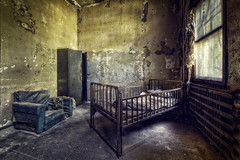Frank C. Grace (Trig Photography) ha aggiunto una foto al pool:
Spring City, PA
May 25th, 2014
That was the name found on the foot of the bed
Some History of the place:
"Pennhurst was constructed and opened in 1908 as a state school for the mentally and physically disabled. Pennhurst’s property was vast, covering 120 acres. Created to house over 10,000 patients at a point in time, Pennhurst was one of the largest institutions of its kind in Pennsylvania. Half of Pennhurst’s residents were committed by court order and the other half were brought by a parent or other guardian. It was devoted strictly to the care, treatment and education of the disabled. Originally named Pennhurst Home for the Feeble Minded and Epileptic, it finally was just called Pennhurst State School. Pennhurst employed a large number of staff to help assist in maintaining the facility. This staff included a board of trustees, medical staff, dental staff, and specialists in psychology, social services, accounting, and various fields of education. The grounds of Pennhurst included a 300-bed hospital, which had a full nursing staff and two surgeons on call at all times. Others at Pennhurst included members of the clergy and farming experts who grew most of Pennhurst’s food . Pennhurst was an essentially self-sufficient community, its 1,400-acre site containing a firehouse, general store, barber shop, movie theatre, auditorium and even a greenhouse. The buildings of Pennhurst were named after towns in Pennsylvania such as Chester and Devon. The original buildings were designed by architect Phillip H. Johnson. All of Pennhurst’s electricity was generated by an on-site power plant. A cemetery lay on the property, as well as baseball and recreational fields for the residents. Many of Pennhurst’s buildings were strictly for storage; however, the majority were dormitory and hospital-style living quarters for the residents. Many of the buildings had security screens that were accessed on the inside, to prevent patients from escaping, or jumping to their deaths. Most of the stairwells had security fences to keep patients from jumping over the railings. Many of the buildings are linked by an underground tunnel system designed for transportation of handicapped patients to and from the dormitory, recreational buildings and dietary.<
Pennhurst was often accused of dehuminazitation and was said to have provided no help to the mentally challenged. The institution had a long history of staff difficulties and negative public image, for example, a 1968 report by NBC called "Suffer the Little Children". Pennhurst State School was closed in 1986 following several allegations of abuse. These allegations led to the first lawsuit of its kind in the United States, Pennhurst State School and Hospital vs. Halderman, which asserted that the mentally retarded have a constitutional right to living quarters and an education. Terry Lee Halderman had been a resident of the school, and upon release she filed suit in the district court on behalf of herself and all other residents of Pennhurst. The complaint alleged that conditions at Pennhurst were unsanitary, inhumane and dangerous, that these living conditions violated the fourteenth amendment, and that Pennhurst used cruel and unusual punishment in violation of the eighth and fourteenth amendments. After a 32-day trial and an immense investigation, prosecutors concluded that the conditions at Pennhurst were not only dangerous, with physical and mental abuse of its patients, but also inadequate for the care and habilitation for the mentally retarded. The Commonwealth of Pennsylvania also concluded that the physical, mental, and intellectual skills of most patients had deteriorated while in Pennhurst.
In 1986, Pennhurst was ordered closed, and began a program of de-institutionalism that lasted several years. Once the buildings were closed, they began to rapidly deteriorate from lack of heating, moisture invasion and vandalism. Thousands of people began to illegally tour the property spray painting everything in sight and breaking all the glass in the place. Theft was rampant and the destruction of the property was in full swing. Patients were thrown out and a large homeless contingent developed in the area.
Pennhurst fell into complete ruin as the complex was shut down. Buildings were abandoned as they were, with patient’s clothes and belonging strewn about. Furniture, cabinets and medical equipment were left to decay as if someone had just got up and walked out the front door. This is the place that will eventually resurrect into one of the most studied properties in the ghost hunter media, and will become an amazing haunted attraction."
SOURCE: SOURCE: www.pennhurstasylum.com/index2.html#/history
